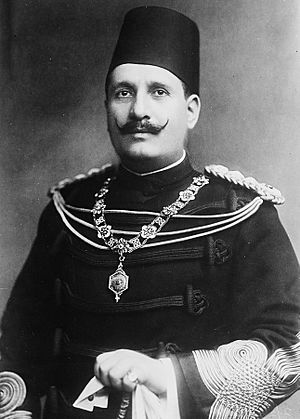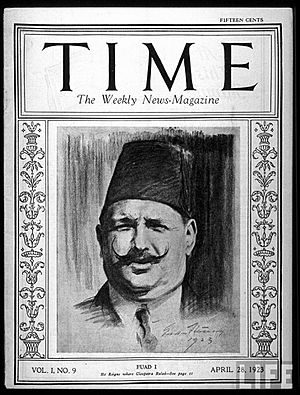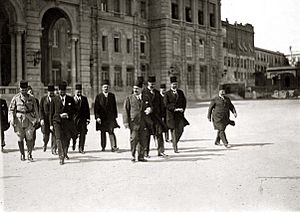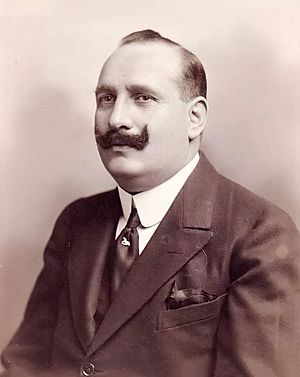Fuad I of Egypt facts for kids
Quick facts for kids Fuad Iفؤاد الأول |
|||||
|---|---|---|---|---|---|

Fuad in 1922
|
|||||
| King of Egypt and Sovereign of Nubia, the Sudan, Kordofan and Darfur | |||||
| Reign | 15 March 1922 – 28 April 1936 | ||||
| Predecessor | Himself as Sultan of Egypt | ||||
| Successor | Farouk I | ||||
| Prime Ministers |
See list
Abdel Khaliq Sarwat Pasha
Muhammad Tawfiq Nasim Pasha Yehya Ibrahim Pasha Saad Zaghloul Pasha Ahmad Ziwar Pasha Adli Yakan Pasha Mustafa el-Nahhas Pasha Muhammad Mahmoud Pasha Isma'il Sidqi Pasha Abdel Fattah Yahya Pasha Ali Mahir Pasha |
||||
| Sultan of Egypt | |||||
| Reign | 9 October 1917 – 15 March 1922 | ||||
| Predecessor | Hussein Kamel I | ||||
| Successor | Himself as King of Egypt | ||||
| Prime Ministers |
See list
Hussein Rushdi Pasha
Muhammad Said Pasha Youssef Wahba Pasha Muhammad Tawfiq Nasim Pasha Adli Yakan Pasha Abdel Khaliq Sarwat Pasha |
||||
| Born | 26 March 1868 Giza Palace, Cairo, Khedivate of Egypt, Ottoman Empire |
||||
| Died | 28 April 1936 (aged 68) Koubbeh Palace, Cairo, Kingdom of Egypt |
||||
| Burial | Al-Rifa'i Mosque, Cairo, Egypt | ||||
| Consort |
Shivakiar Ibrahim
(m. 1895; div. 1898)Nazli Sabri
(m. 1919) |
||||
| Issue | Prince Ismail Princess Fawkia Farouk I of Egypt Fawzia, Queen of Iran Princess Faiza Princess Faika Princess Fathia |
||||
|
|||||
| House | Alawiyya | ||||
| Father | Isma'il I | ||||
| Mother | Ferial Qadin | ||||
| Religion | Sunni Islam | ||||
Fuad I (born Ahmad Fuad; 26 March 1868 – 28 April 1936) was an important ruler of Egypt and Sudan. He was first the Sultan and later became the King of Egypt. He was the ninth ruler from the Muhammad Ali dynasty.
Fuad became Sultan in 1917, taking over from his older brother, Hussein Kamel. In 1922, the United Kingdom declared Egypt an independent country. At this time, Fuad changed his title from Sultan to King.
Contents
Early Life and Education
Fuad was born in Giza Palace in Cairo, Egypt, on March 26, 1868. He was the fifth child of Isma'il Pasha, who was a ruler of Egypt.
Fuad spent his childhood living in Naples, Italy, with his father. He received his education at a military school in Turin, Italy. His mother was named Ferial Qadin.
Fuad's Early Career
Before becoming Sultan, Fuad helped create the Egyptian University. He was the university's first leader, called a rector, starting in 1908. He held this job until 1913.
In 1913, Fuad tried to become the king of Albania. Albania had just become independent from the Ottoman Empire. At that time, his nephew, Abbas II, ruled Egypt and Sudan. It seemed unlikely Fuad would become ruler in his own country. This is why he looked for the throne of Albania. Fuad also led the Egyptian Geographic Society from 1915 to 1918.
Becoming King of Egypt
Fuad became the ruler of Egypt after his brother, Hussein Kamel, passed away in 1917. At first, he was known as the Sultan of Egypt.
After the Egyptian Revolution of 1919, the United Kingdom decided to end its control over Egypt. On February 28, 1922, Egypt was recognized as an independent country. This was a big moment for Egypt.
On March 15, 1922, Fuad made an official announcement. He changed his title from Sultan of Egypt to King of Egypt. This showed Egypt's new independent status.

Changes to the Constitution
In 1923, a new constitution was created for Egypt. This constitution gave King Fuad a lot of power. He often used his right to dissolve Parliament, which meant he could end the government's meetings.
During his time as king, governments were often changed by his decision. Parliaments, which are like law-making groups, never stayed for their full four-year term. They were often dissolved by the King's order.
In 1930, King Fuad tried to make his own power even stronger. He got rid of the 1923 Constitution. He replaced it with a new one that gave Parliament only an advisory role. This meant Parliament could only give advice, not make strong decisions. However, many people were unhappy about this. Because of public demand, he brought back the earlier constitution in 1935.
Royal Archives and History
King Fuad was very interested in Egyptian history. He helped create the Royal Archives in the 1930s. He hired many people to copy and organize old letters and documents. These documents were about his family, especially his great-grandfather Muhammad Ali.
Fuad wanted to show his ancestors as great leaders and patriots. His work had a lasting impact on how Egyptian history was written.
Family Life
Fuad was married twice. His first wife was Princess Shivakiar Khanum Effendi. They married in 1895. They had two children: a son named Ismail Fuad, who sadly passed away as a baby, and a daughter named Fawkia. They divorced in 1898.
His second wife was Nazli Sabri. They married in 1919. With Nazli, Fuad had five children. Their son was King Farouk, who would become the next king. They also had four daughters: Princess Fawzia, Princess Faiza, Princess Faika, and Princess Fathia. Princess Fawzia later became the Queen of Iran.
King Fuad passed away on April 28, 1936, at the Koubbeh Palace in Cairo. He was buried in the ar-Rifai Mosque in Cairo.
After King Fuad's death, his wife Nazli lived as a widow. She later moved to the United States.
Titles Held by Fuad I
- 26 March 1868 – 9 October 1917: His Highness Ahmed Fuad Pasha
- 9 October 1917 – 15 March 1922: His Highness The Sultan of Egypt and Sudan
- 15 March 1922 – 28 April 1936: His Majesty The King of Egypt and Sudan
See also
 In Spanish: Fuad I de Egipto para niños
In Spanish: Fuad I de Egipto para niños
- Kingdom of Egypt
- List of monarchs of the Muhammad Ali dynasty



